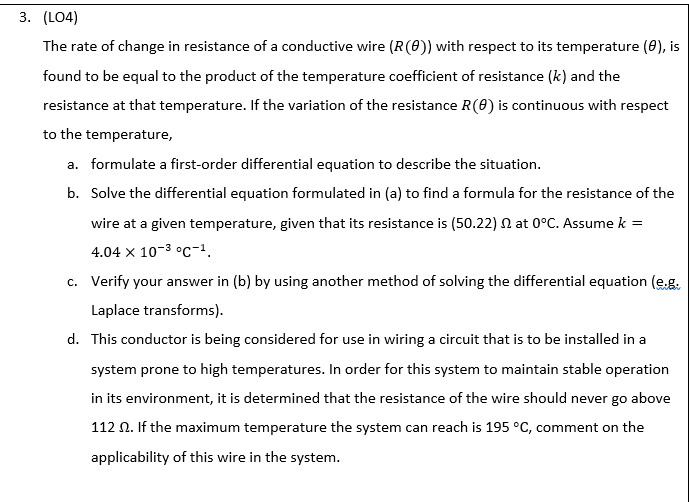3. (LO4) The rate of change in resistance of a conductive wire (R(0)) with respect to its temperature (0), is found to be equal to the product of the temperature coefficient of resistance (k) and the resistance at that temperature. If the variation of the resistance R(0) is continuous with respect to the temperature, a. formulate a first-order differential equation to describe the situation. b. Solve the differential equation formulated in (a) to find a formula for the resistance of the wire at a given temperature, given that its resistance is (50.22) N at 0°C. Assume k = 4.04 x 10-3 °C-1. c. Verify your answer in (b) by using another method of solving the differential equation (e.g. Laplace transforms). d. This conductor is being considered for use in wiring a circuit that is to be installed in a system prone to high temperatures. In order for this system to maintain stable operation in its environment, it is determined that the resistance of the wire should never go above 112 N. If the maximum temperature the system can reach is 195 °C, comment on the applicability of this wire in the system.
3. (LO4) The rate of change in resistance of a conductive wire (R(0)) with respect to its temperature (0), is found to be equal to the product of the temperature coefficient of resistance (k) and the resistance at that temperature. If the variation of the resistance R(0) is continuous with respect to the temperature, a. formulate a first-order differential equation to describe the situation. b. Solve the differential equation formulated in (a) to find a formula for the resistance of the wire at a given temperature, given that its resistance is (50.22) N at 0°C. Assume k = 4.04 x 10-3 °C-1. c. Verify your answer in (b) by using another method of solving the differential equation (e.g. Laplace transforms). d. This conductor is being considered for use in wiring a circuit that is to be installed in a system prone to high temperatures. In order for this system to maintain stable operation in its environment, it is determined that the resistance of the wire should never go above 112 N. If the maximum temperature the system can reach is 195 °C, comment on the applicability of this wire in the system.
Power System Analysis and Design (MindTap Course List)
6th Edition
ISBN:9781305632134
Author:J. Duncan Glover, Thomas Overbye, Mulukutla S. Sarma
Publisher:J. Duncan Glover, Thomas Overbye, Mulukutla S. Sarma
Chapter11: Transient Stability
Section: Chapter Questions
Problem 11.18P
Related questions
Question
The rate of change in resistance of a conductive wire ( ) with respect to its temperature ( ), is found to be equal to the product of the temperature coefficient of resistance ( ) and the resistance at that temperature. If the variation of the resistance is continuous with respect to the temperature,

Transcribed Image Text:3. (LO4)
The rate of change in resistance of a conductive wire (R(0)) with respect to its temperature (0), is
found to be equal to the product of the temperature coefficient of resistance (k) and the
resistance at that temperature. If the variation of the resistance R(0) is continuous with respect
to the temperature,
a. formulate a first-order differential equation to describe the situation.
b. Solve the differential equation formulated in (a) to find a formula for the resistance of the
wire at a given temperature, given that its resistance is (50.22) N at 0°C. Assume k =
4.04 x 10-3 °С-1,
c. Verify your answer in (b) by using another method of solving the differential equation (e.g.
Laplace transforms).
d. This conductor is being considered for use in wiring a circuit that is to be installed in a
system prone to high temperatures. In order for this system to maintain stable operation
in its environment, it is determined that the resistance of the wire should never go above
112 N. If the maximum temperature the system can reach is 195 °C, comment on the
applicability of this wire in the system.
Expert Solution
This question has been solved!
Explore an expertly crafted, step-by-step solution for a thorough understanding of key concepts.
Step by step
Solved in 5 steps

Knowledge Booster
Learn more about
Need a deep-dive on the concept behind this application? Look no further. Learn more about this topic, electrical-engineering and related others by exploring similar questions and additional content below.Recommended textbooks for you

Power System Analysis and Design (MindTap Course …
Electrical Engineering
ISBN:
9781305632134
Author:
J. Duncan Glover, Thomas Overbye, Mulukutla S. Sarma
Publisher:
Cengage Learning

Power System Analysis and Design (MindTap Course …
Electrical Engineering
ISBN:
9781305632134
Author:
J. Duncan Glover, Thomas Overbye, Mulukutla S. Sarma
Publisher:
Cengage Learning